- Roadmap Table of Contents
- Part 1: General Milestones
- Part 2: Utilization and Development of Cislunar Space
- Part 3: To the Moon
- Part 4: To Mars (this page)
- Part 5: Asteroid Mining and Orbital Space Settlements
- Part 6: Additional Expansion and Greater Sustainability of Human Civilization
With a gravity about one-third that of Earth’s and twice that of the Moon, an atmosphere averaging one percent of the density of Earth’s, an axial tilt and a day-length very similar to Earth’s, and vital deposits of volatiles like water, Mars beckons to provide another world for humankind.
 Image: Javier Arizabalo
Image: Javier Arizabalo
PARTICULAR BARRIERS:
Major Barriers specific to Mars will have to be overcome to reach the Milestones en route to the settlement of that planet. Those Barriers include:
Psychological. Mars is a long way from Earth. With current technology it is more than a 6-month journey each way and, on account of orbital mechanics, pragmatically accessible from Earth for only a short launch window every two years. A single round trip would last either about 500 days, allowing only a short 30-60 day stay on the surface before the launch window for return to Earth would close (opposition mission), or about 900-1050 days, allowing 500 days for on-surface operations (conjunction mission). This great distance could create a feeling of isolation by the crew members or settlers.
Governmental. A lack of any government decision to support a practical human Mars expedition, or to allow or disallow a private Mars expedition, is a barrier.
Political. The lack of political support to create a permanent and growing human presence on Mars is a barrier. With trips so infrequent, lasting so long, and with relatively few or exciting on-surface events, public interest is likely to vary. Where public interest wanes, a decline in political support usually follows.
Goal Definition. Early government-led human Mars exploration runs the risk of ending up as “flags and footprints” or “grab (rocks) and go” missions followed by the “been there-done that” lethargy that ended the Apollo lunar program. This risk will be lessened to the extent that the goal is a continued human presence and human settlement on Mars by private and/or government efforts, and that mission architectures are designed from the very beginning as a sustainable, reusable, integrated system that pursues ISRU and technologies for self-sufficiency.
Biological. As with the Moon, there are two major potential barriers to the permanent human settlement of Mars: radiation and gravity.
(1) While solar radiation is diminished on account of Mars’ distance from the Sun and Mars’ thin atmosphere, it can be lethal for unprotected life on the surface. Extra-solar cosmic radiation would be somewhat diminished by the Mars atmosphere compared to the lunar surface. Methods to shield habitats, and humans operating on the surface, will need to be developed.
(2) Martian gravity, although twice that of the Moon, is still only one-third that of Earth. Whether complex terrestrial life can thrive and reproduce under such conditions is unknown. This barrier can be tested by in-space variable-gravity centrifuges or by actual on-planet experience.
Certain Martian Characteristics. Unique challenges of the Martian environment will have to be overcome – such as Mars dust and dust storms, hazardous soil chemistry, accessibility to water, vehicle-trapping sand, low night temperatures and acclimation to slightly longer days.
Planetary Protection. At the current time, the possibility of life on Mars seems remote, but cannot be totally excluded. It is unlikely that the existence or non-existence of life on Mars can be proved by robot probes alone. There are those who feel that until some definitive result is obtained all spacecraft must undergo the most strenuous sterilization process at great cost, and that no humans should walk on Mars. This viewpoint could prevent the settlement of Mars for centuries if implemented strictly. In addition, unreasonably strict sterilization regulations, which never could eliminate microbes carried by humans, could work to make human trips to Mars prohibitively expensive or impossible.
MILESTONE 22. Robotic Exploration of Mars for Local (In Situ) Resources
Satellites orbiting Mars and robotic landers, supplemented if needed by rovers teleoperated by an orbiting crew, determining the location, nature and extent of Martian resources, especially ice, guiding the choice of the best sites for follow-on human missions.
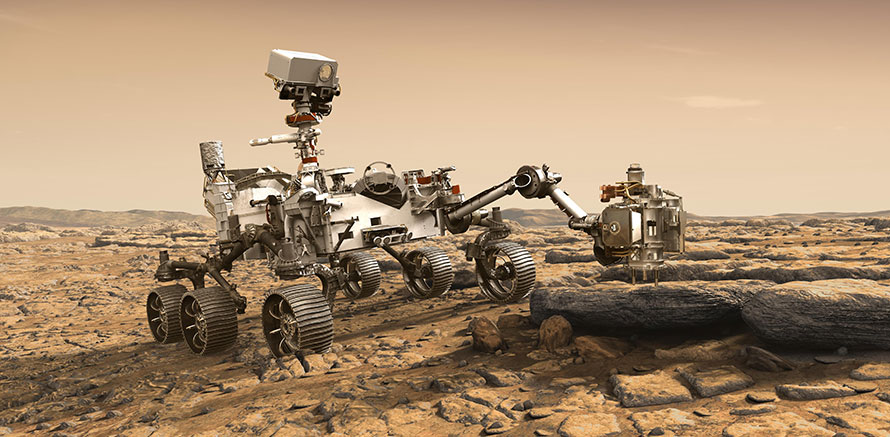 The Mars 2020 rover will include the Mars Oxygen In-Situ Resource Utilization Experiment (MOXIE) to demonstrate the production of oxygen from the Martian atmosphere for propellant and for breathing. Image: NASA
The Mars 2020 rover will include the Mars Oxygen In-Situ Resource Utilization Experiment (MOXIE) to demonstrate the production of oxygen from the Martian atmosphere for propellant and for breathing. Image: NASA
DESCRIPTION
Robotic missions to Mars, both orbiters and landers, have provided and are currently providing tantalizing hints about Martian geological history. Continuing missions, utilizing the favorable launch windows that occur about every 26 months, may be entirely robotic or supplemented by crewed missions to a Martian moon or even low Mars orbit. From this location the crew could (a) teleoperate Mars landers without the long delay in radio transmissions to and from Earth, (b) explore that moon, and (c) test equipment that later could be used on Mars. Unless (by the time we are ready for the first human landing on Mars) we have identified a clearly superior landing site for the initial human surface base, such a crewed orbital mission may be needed to teleoperate rovers to determine “ground truth” about which site is best.
There are two fundamental objectives of such missions:
1. Scientific Knowledge. One fundamental objective of these missions will be to continue to learn more and more about the planet’s geological history, both to understand it for its own scientific value and to ascertain if there are any implications as to Earth’s own history and future. In particular, these missions would be searching for:
- The existence of Martian life of any kind.
- Evidence of past Martian life, now extinct.
- Exact locations, purity and amounts of surface and buried ice or liquid water, especially near the surface and near the equator.
- Locations with thick layers of rocks for dating to provide an accurate geological history.
- Geological implications from diverse soil and rock samples that help us compare the Earth to Mars.
- Locations and amounts of valuable minerals and metal ores such as hematite.
- An understanding of Martian weather, seasons and atmosphere.
- Indications of any biological or other contaminants that could be harmful if returned to Earth.
- Rates of loss of the Mars atmosphere from solar wind stripping and photolysis of water.
2. Data for Human Exploration and Outposts. The other fundamental objective of these robotic Mars missions will be to be ascertain existing conditions that are favorable or unfavorable to human exploration and settlement on the planet, especially near the Martian equator where less fuel is required to land and return to orbit. In particular, these missions would:
- Search for the best sites for follow-on human activities.
- Search for ice or water sources that will be the most accessible to humans.
- Search for any deep brine layers and concentrations of other minerals that might be useful to humans.
- Test a wide variety of materials and machines against the Martian environment, to determine how well they will remain sturdy and operable over long periods of time, while exposed to wind, dust, radiation, daily temperature fluctuations, and seasonal changes.
- Test various robotic rover designs in ever longer traverses over varied Martian terrain.
- Test prototypes of in situ resource utilization (ISRU) equipment to (1) automatically convert Martian carbon dioxide and excavated ice to fuels (including rocket propellants) and oxygen and (2) eventually convert solid minerals into structural materials.
- Test a variety of energy supply and backup systems.
- Test automatic and/or teleoperated equipment designed to excavate and transport ice to a fuel production plant.
- Test automatic construction techniques both in and using Martian soil.
- Test for the best methods for growing food plants on Mars, on the surface or below ground.
With favorable launch windows existing only about every 26 months, determining the tradeoffs as to which measuring instruments and which test equipment and which rovers will be sent on any particular mission, and in what order, will provide challenges for policy makers.
COMPLETION
The first objective of this milestone (scientific knowledge) may never be fully completed, as scientific investigation is open-ended. The second objective (exploration and outpost data) can be considered achieved when there is agreement on at least three viable surface sites for future human development, all of which have an ice source nearby.
MILESTONE 23. An Integrated Martian Space Transportation and Logistics System
An integrated and sustainable system capable of safely transporting humans and cargo from Earth and/or cislunar space to the Martian surface, maintaining the crew on the surface, and having the ability to return the crew back to Earth or cislunar space.
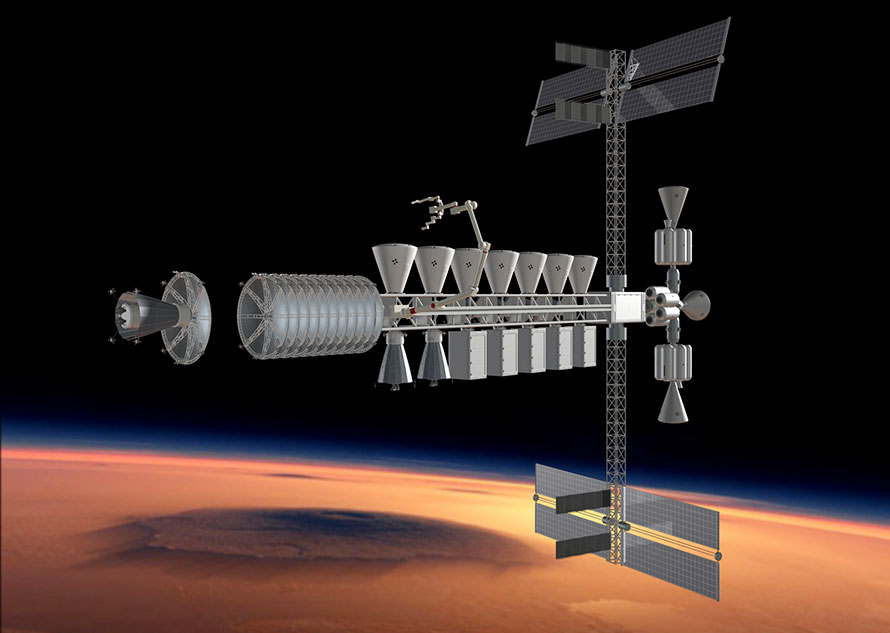
Logistics base in Mars orbit with habitat modules (right) and multiple docking ports for vehicles, propellant depots, and aerocapture shields. Image: [email protected]
DESCRIPTION
Initial Mars bases will depend upon a transport and logistics connection to Earth or cislunar space. Three critical factors in creating a safe transportation and logistics system are (1) reliability and redundancy in vehicles, equipment and supplies, (2) adequate radiation shielding and (3) having a well-trained medical crew member.
Reaching and returning from Mars, with its great distance from Earth, will be significantly more difficult than similar operations on the Moon. On account of that distance, equipment or supplies that fail on Mars cannot be easily replaced. An unexpected failure that might be recoverable from on the Moon, only a few days away from Earth, could be fatal on Mars. Consequently, materials and equipment destined for use at Mars should be especially well designed, manufactured and tested for high reliability.
Due to the distance and years-long rescue time, it is extremely important that all human Mars trips use the principle of redundancy. It is especially important to have more than one crew habitat vehicle which can support the entire crew, and more than one main propulsion vehicle, which can propel the entire system, in case of accident or equipment failures, at every phase of the operation. This allows the crew to perform self-rescue, and significantly reduces the problem of distance from Earth as a major crew safety issue.
Unless we are discussing one-way trips to Mars, decisions will be made about whether, after a 6- to 8 month journey, to undertake a 500-day stay (conjunction type mission) or just a 30-45 day stay (opposition type mission). That decision will drive the planning for the transportation, landing, habitation, supply and Earth return systems.
For an ongoing series of Mars expeditions, opposition missions are much less desirable than conjunction missions. The opposition mission type requires leaving Mars orbit within about six weeks of initial arrival time, leaving little time to accomplish much, including repairs if necessary.
Earth to Mars Transportation Systems. Architectures proposed for the transportation systems needed to transit between Earth orbit and Mars orbit include vehicles where the crew will be in microgravity during transit or vehicles using tethers or other methods to create “artificial gravity” by rotation. Most systems contemplate using chemical propellants of one kind or another. Other proposed propulsion systems include nuclear-thermal propulsion and electric propulsion (e.g. ion and plasma). Electric propulsion is currently better suited for cargo than for human transport, and may become more important as both solar cells and electric thrusters are improved. While the preferred goals and payload ought to be the determinants of the appropriate transportation system, the sequence may be just the opposite, with the choice of a transportation system determining the length or the trip type, the resulting stay options at Mars, and the tonnage that can be brought along. The choice of architecture will be influenced by the strength of the desire to have humans on Mars, tempered by the state and cost of then-available technology. Reusable transit vehicles that can return to Earth orbit or to a logistics base at a cislunar location would greatly reduce costs for repeated Mars flights. Many concepts propose Mars flights leaving from a cislunar location such as the Earth-Moon L1 point (EM-L1) and using lunar-derived propellant to reduce the mass of propellant that otherwise would need to be lifted from Earth.
Earth Orbit to Mars Orbit on a “Cycler.” A large cycling spacecraft that moves between the two planets in a regular period, without actually entering into orbit around Mars or Earth, would require less fuel and, since it can be very massive, can provide much more radiation protection for its passengers. It would require very high reliability and redundancy for the transfer (taxi) vehicles at each end of the trip, since the cycler will not wait for launch delays. Due to the requirement for multiple transfer vehicles at each end of the trip, the cycler system might not be used extensively until later in the development of civilian transport to Mars.
Mars Surface Landing Systems. Many transportation concepts have been proposed for landing methods, such as:
- Earth (or Earth orbit) directly to the Martian surface (direct entry). Variations in landing systems include aero-braking (either with direct insertion from Earth or using multiple orbital passes), parachutes, braking rockets, or combinations of them. Such methods could be used by systems which have very high landing accuracy and do not depend on any orbital base or propellant depot.
- Earth (or Earth orbit) to a Martian moon and then in a separate spacecraft to the surface of Mars. This creates an additional delta-V (propulsion) penalty of about 1 kilometer per second for a round trip ending back at the Martian moon.
- Earth (or Earth orbit) to an orbital facility or an Earth return vehicle orbiting around Mars and then to the surface of Mars (entry from orbit). Such concepts generally will use a separate lander using one of the landing techniques considered for direct entry.
Entry, Descent and Landing (EDL) techniques. Landing methods for human-sized Mars vehicles will be different from those used for Apollo or for the Mars rovers and landers on account of the thinner atmosphere and different gravity. By 2004, NASA scientists discovered that no one knew how to land large crewed vehicles on Mars. Landing on Mars takes about one-third or less of the propulsive deceleration than is needed for a lunar landing, even though Mars gravity is about twice that of the Moon. Although the landing trajectory can be complicated by short term variations in atmospheric pressure, the thin Mars atmosphere serves as an excellent air brake for a landing vehicle at high speeds (over about Mach 2.5) and can get rid of over two-thirds of the total entry velocity from orbit. However, for final descent and landing at speeds below about Mach 2.5, the air is too thin to slow large vehicles sufficiently, even with gigantic parachutes. Combinations of deceleration methods including the large parachutes were supported up until 2015.
A likely solution to this problem is Supersonic Retro-Propulsion (SRP), which is the use of rocket engines firing toward the vehicle’s direction of motion, a technique that was first demonstrated by the successful re-entry and subsequent landing of Falcon 9 rocket first stages in 2015. A team of NASA scientists analyzed the Falcon 9 rocket entry plume videos and concluded that this technique would work for other types of re-entry vehicles. The large parachute systems for human-sized Mars vehicles were deemed impractical and have been abandoned.
Earth Return Systems. Various architectures have been proposed for a return to Earth, such as:
- Direct return from the Martian surface to Earth (or Earth orbit) using the original landing vehicle. This is the transportation model SpaceX proposed, where the transit vehicle is also the lander, making it very large.
- Direct return from the Martian surface to Earth (or Earth orbit) using a separate return vehicle (called a Mars Ascent Vehicle or MAV), either attached to the original landing vehicle or pre-positioned in a previous uncrewed mission.
- The original crew transit vehicle (which may be docked at an orbiting base) stays in a circular Low Mars Orbit (LMO). The crew returns to Mars orbit in a reusable Mars Ferry to rendezvous with the transit vehicle, which subsequently returns to Earth, Earth orbit or EM-L1.
- The Earth return vehicles (including habitat modules) are left in a High Elliptical Mars Orbit (HEMO) which preserves much of the needed departure velocity while the crew is operating surface missions from Low Mars Orbit. The crew can be transferred between orbiting base habitats and the Earth return habitats in small ferry vehicles for a very small amount of fuel.
- Rendezvous from Mars orbit with an “Aldrin cycler” on its way past Mars for a return to Earth orbit. The main issue here is that the cycler cannot wait for a launch delay, so at least two ferries could be used simultaneously during a flight to a cycler, so that if one ferry has a propulsion failure, the passengers can transfer to the other one. The cycler may eventually be able to play a significant role in moving large numbers of civilian passengers to Mars.
Orbital Propellant Depot. Mars landing vehicles need to bring some propellant from Earth to be used for the initial landings of the fuel production equipment (“bootstrapping” propellant). Insulated tanks of fuel brought to Mars can remain in Mars orbit as cryogenic propellant depots. These depots would also be available to store propellant made on Mars from in situ resources and brought up by reusable Martian “ferries.” This stored fuel could then be used for future trips to the surface, for trips to Phobos and Deimos, and/or for Earth return vehicles. The depot(s) could be berthed at an orbiting base.
Orbital Logistics Base. A Low Mars Orbit base would provide the easiest location to reach the Martian surface, and could provide (1) a crew refuge and orbital habitation before landing, (2) logistics capacity to load cargo into Mars ferries, (3) places to berth propellant depots, (4) places to dock Mars ferries and cargo vehicles from Earth and (5) additional science capacity for base site selection, surface monitoring and rover control. A near-equatorial orbit at 400 km high allows the lowest transport fuel requirements for round trips to the surface and back.
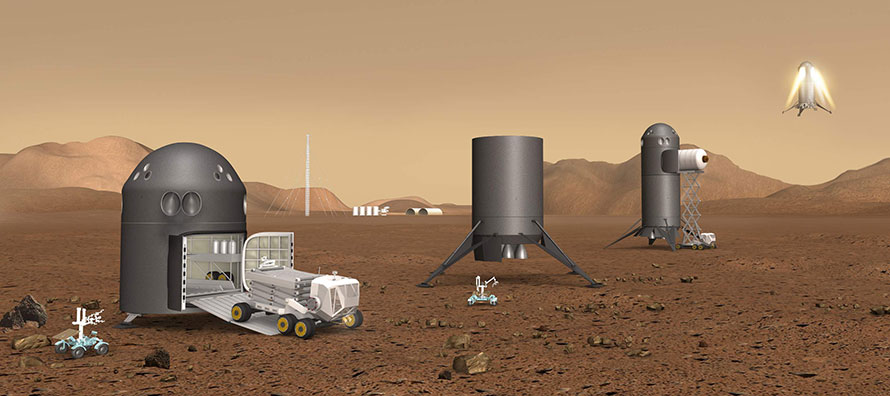 Langley Hercules reusable Mars ferry concept. First lander carries a loader and is expendable, but subsequent landers are reusable. Image: [email protected]
Langley Hercules reusable Mars ferry concept. First lander carries a loader and is expendable, but subsequent landers are reusable. Image: [email protected]
Martian Ferries. Having fuel produced on Mars can facilitate continued use of reusable vehicles that return directly to Earth or reusable Mars ferries that go to Mars orbit, rather than single-use “land and abandon” vehicles (Mars landers) and single use Mars Ascent Vehicles (MAVs). This would greatly reduce the tonnage needed from Earth for transportation purposes during construction of an expanded Mars base and thereafter. Initial missions would land propellant production facilities that could be assembled on the Martian surface. Observations since 2010 have shown vast deposits of subsurface water ice in many parts of Mars. Situating a base near a proven ice deposit would allow in situ production of liquid oxygen-hydrogen or oxygen-methane propellants.
Some combinations of these propellants are energetic enough to allow a ferry on the surface to perform a direct Earth return or to allow ferries to reach orbit and return to the Martian surface with a large payload on the same load of propellant, and even leave extra fuel in an orbital depot. Ultra-light structural engineering may also allow liquid methane and oxygen propellants to be used by Mars ferries without orbital refueling. Nearby subsurface water ice would be even more advantageous if confirmed near the equator, where it is believed to exist, because it requires less fuel to reach orbit from the equator and to land near the equator. For this reason, verifying that a landing site has a water ice supply has been considered by NASA since 2015 to be a critical issue prior to human landing missions.
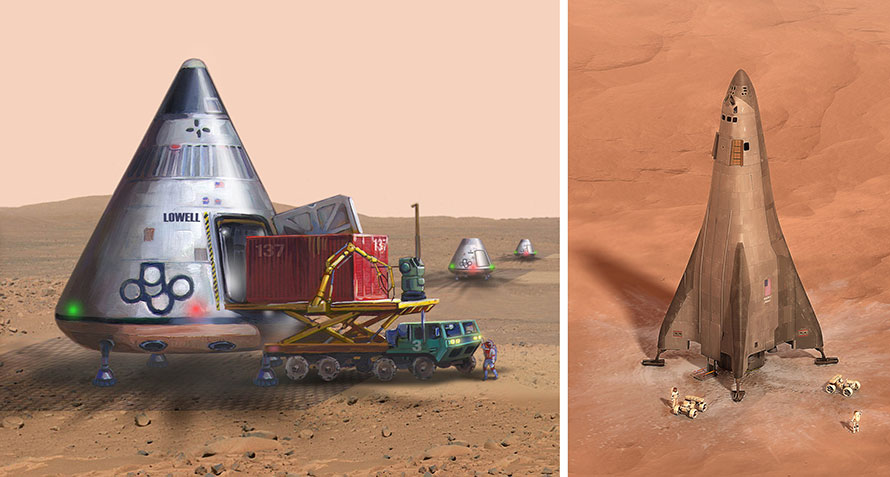 Other reusable Mars ferry concepts. Images: Marcus Mashburn; Lockheed-Martin
Other reusable Mars ferry concepts. Images: Marcus Mashburn; Lockheed-Martin
Surface Habitation Systems. The technological and logistical requirements for orbital and surface crew habitats will depend on whether a short or long stay on Mars is planned. The longer the stay, the more supplies will be required and/or fewer crew will be possible. For a short (1 month) opposition stay, the surface habitat may be the lander itself or a pre-positioned habitat.
For a long (500 day) conjunction stay, a pre-positioned surface habitat is likely, possibly supplemented by a supply of oxygen or rocket fuel extracted from the Martian environment by contemporaneously built or pre-positioned ISRU equipment. Site location will probably be determined by availability of large deposits of water ice nearby as a source of water, oxygen, and propellants. A conjunction mission will require a shielded or buried surface habitat. An important piece of equipment is an earthmover that can move the Martian soil to cover habitat modules with regolith to provide shielding from radiation, and also to excavate buried ice. It is likely that conjunction missions will be chosen.
Orbital Crew Habitats. Orbital habitats would be an integral part of an Orbital Logistics Base. Their extent and supply requirements depend heavily on what kind of mission is planned. For a short surface mission, the orbital habitat could serve as a crew refuge. If a long, orbit-only mission is planned so a crew can help locate a good surface base site, the habitat would need extensive supplies and the same level of radiation shielding as during a transit. The habitat also might need artificial gravity. If Earth return vehicles are left in Low Mars Orbit for a short mission, those vehicles can serve as the habitat.
To the extent the entire Mars transportation system is based on reusable vehicles, rather than ones thrown away after a single use, the exploration, development and settlement of Mars will be greatly facilitated and the cost greatly reduced. For example, fewer vehicles will be needed, extra vehicles may be available for redundancy, more cargo can be delivered to the surface, and crew risks may be reduced by not having to use a new untested vehicle each time.
BARRIERS
- Continued reliance by some on all-expendable spacecraft designs for Mars mission planning.
- Continued focus by some on “Flags and Footprint” type missions with no infrastructure left behind.
- Perception that Mars missions must be very high cost.
- Insistence that due to high costs, Mars missions must be minimalist with only one vehicle of each type, resulting in a total lack of vehicle redundancy and greatly increasing risk to the mission and the crew.
- Lack of a cislunar transport and logistics system to L1, L2 or other location near the Moon.
- Lack of a lunar polar mining base to provide fuel for routine Mars transits.
- Lack of governmental adoption of designs for fully re-usable Mars ferries.
- Lack of advanced orbiting radars at Mars to pinpoint near-surface ice deposits.
- Concerns about and lack of agreement on planetary protection protocols for human bases on Mars.
COMPLETION
This Milestone can be considered achieved when
- (1) cargo and crews can be moved from Earth or cislunar space to Mars orbit or surface and
- (2) between Mars orbit and Mars surface (back and forth local transport) and
- (3) sustained on the Mars surface safely during at least an approximately 500-day surface stay and
- (4) the crews safely leave the Martian surface and
- (5) then returned to Earth, and
- (6) the transport system has been used to safely move at least three successive crews over seven years between Mars orbit and Mars surface and return the surface crews to Earth safely, and
- (7) steps 2, 3 and 4 use locally produced propellant.
MILESTONE 24. A Continuously Occupied Multi-Purpose Mars Surface Base
Following identification of a suitable base location and the selection of the particular infrastructure and equipment needed there, establishment of a continuously occupied multi-purpose Mars surface (or sub-surface) base.
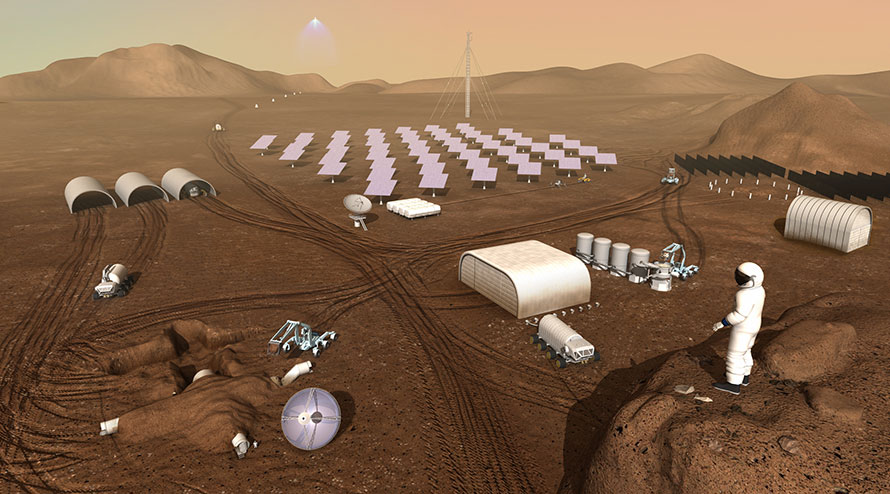
Mars base with buried crew habitats, solar and nuclear power production, ice mining, propellant production and storage, and distant launch and landing site. Image: [email protected]
DESCRIPTION
Crews landing on Mars will continue the exploratory work begun by satellites and robotic landers. The ability of humans to use tools, travel faster and over greater distances (whether on foot or by rover), recognize and investigate features faster than robots, and adapt to new circumstances, will greatly accelerate the accumulation of knowledge, especially that necessary to build a permanent outpost.
The first crews will experiment with ISRU technology and test, among other things, alternative power sources, habitats, propellant manufacturing techniques, oxygen extraction processes, gardening, mining equipment, ground transport, air transport (e.g., balloons, Mars airplanes, and even rocket “hoppers”), construction techniques and other equipment. The crews will give special attention to extracting and using ice from deposits in the immediate landing area to produce water, oxygen and rocket fuel, allowing their vehicles to return to Earth or Mars orbit.
If the transportation architecture resulted in landings on a Martian moon, crews stationed there will make similar tests on that moon. They also will probably give special attention to locating craters or other areas suitable for permanent underground quarters shielded from radiation.
Any surface base that is designed or intended to be temporary could be a dead end. It would waste crucial logistics resources such as the fuel production plant and everything else needed to support the base and the ascent vehicles, or would require the use of all expendable vehicles, making such Mars expeditions too expensive to either accomplish or maintain. If possible, the very first surface base should be intended to be permanent unless and until surface investigations show it is not a good site.
At some point a decision must be made to concentrate efforts on a primary base location, either the site of a previous landing or a newly selected site. Most likely the site chosen will be near shallow deposits of ice and surface mineral deposits such as iron oxide and sulfur, which can provide many of the essential elements needed for long-term habitation and which will reduce substantially the re-supply tonnage needed. If possible, the site would be located near a geological boundary which could provide access to multiple critical mineral deposits. That primary site may grow into the first continuously occupied human base.
As with a base on the Moon, this base will likely be occupied by a rotating group of inhabitants as well as by some who may stay permanently. The crew will be housed underground, in standardized habitation modules that are partly buried under several meters of regolith by an excavator for essentially complete radiation protection. It also may be housed in a suitable cave or lava tube. The base will probably be powered by a combination of solar power and buried nuclear reactors, since there are no fossil fuels on Mars. It should have stores of food for at least three years. The base should among other things:
- Continue scientific research and exploration of Mars, but with crew members on the surface instead of only robots.
- Start or expand fuel production from Mars ice and CO2, and create fuel storage facilities.
- Start or expand mining activities and develop techniques for locating and making use of in situ resources such as iron oxide, feldspar in basalt, and sulfides.
- Initiate deep drilling to attempt to find any brine layers below the permafrost layer (or cryosphere), where microorganisms (existing or extinct) and useful dissolved mineral salts are most likely to be found.
- Use Martian minerals to create structural materials to build and/or to shield habitats.
- Eventually cater to visiting scientists and tourists in increasing numbers.
Private commercial services may be established near the base, and over time the focus of the base may shift towards commercial uses. Alternatively, the initial base may be established by a commercial entity, and rent space or services to government users.
BARRIERS
- Lack of orbiting radar precise enough to locate ice deposits at proposed base sites.
- Uncertainty on the amount and location of important minerals such as iron oxide and sulfides.
- Concerns about and lack of agreement on planetary protection protocols for human bases on Mars.
- Lack of planning for and implementation of crew time-saving systems so that the crew has time to perform work other than just managing life support and equipment maintenance.
- Development of habitats, materials and machines that can survive and function with Martian dust.
COMPLETION
This Milestone can be considered achieved when a Mars surface base has been continuously occupied for one decade.
MILESTONE 25. A True Martian Settlement (making us a multi-planetary species)
The Martian base evolving into a permanent settlement, increasingly self-sufficient and increasingly focused on commercial activities.
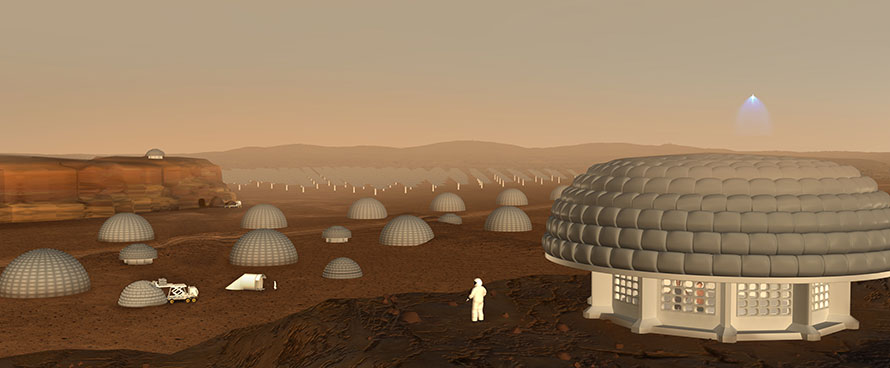
Early Mars city partially underground with shielded buildings and cupolas. Image: [email protected]
DESCRIPTION
The Martian base will continue to evolve, growing in volume, in area, in the number of habitat modules connected or nearby, and, especially, in population. At some point the decision will be made that the site is to be a permanent settlement if it has sufficient resources. The distinguishing characteristics of that settlement will include:
- people emigrating to Mars with no intention of ever returning to Earth,
- children being brought to Mars, and being born there,
- reasonable self-sufficiency having been demonstrated, including basic life support, stable food production, ability to construct additional habitation spaces from local materials with on-site equipment,
- a recognition that in case of emergency it will be impossible to evacuate the entire population and a willingness to bear that risk (as was the case on terrestrial frontiers), and, consequently, no requirement that enough vehicles be standing by for that purpose,
- enough habitat space to house all of the inhabitants in an emergency if part of the settlement is damaged.
- reasonably adequate medical and surgical facilities, comparable to a rural hospital on Earth.
- a “local” economy, with the inhabitants serving each other’s needs, as in small isolated villages on Earth,
- facilities for visitors, whether scientists, tourists, or others.
Whether humans and other mammals can survive and thrive for long periods of time, and reproduce and grow to adulthood successfully, in the one-third gravity of Mars remains to be determined, with or without advanced biomedical intervention.
As the cost of space transportation drops and the cost of the settlement is amortized or written off, emigrants from Earth should be able to pay all or at least part of the cost of their relocation. On Mars, commercial activities and experiments that were initiated in the base phase may be expanded, including tourism. Hotels may be among the structures added to the settlement. An increasing proportion of Martian settlers may be involved in such commercial activities.
It is anticipated that the majority of initial Mars settlements and buildings will be below ground so that the civilian population is not exposed to the surface radiation environment. Underground pedestrian and vehicular tunnels will probably connect most of the habitats in each community. Some buildings will be partly on the surface but will be shielded with Mars regolith generated by excavation. Some separate communities may be connected by subways. Psychological pressure for a view of the outdoors may result in the creation of above ground cupolas to allow anyone, even children, to see outdoors without significant radiation exposure.
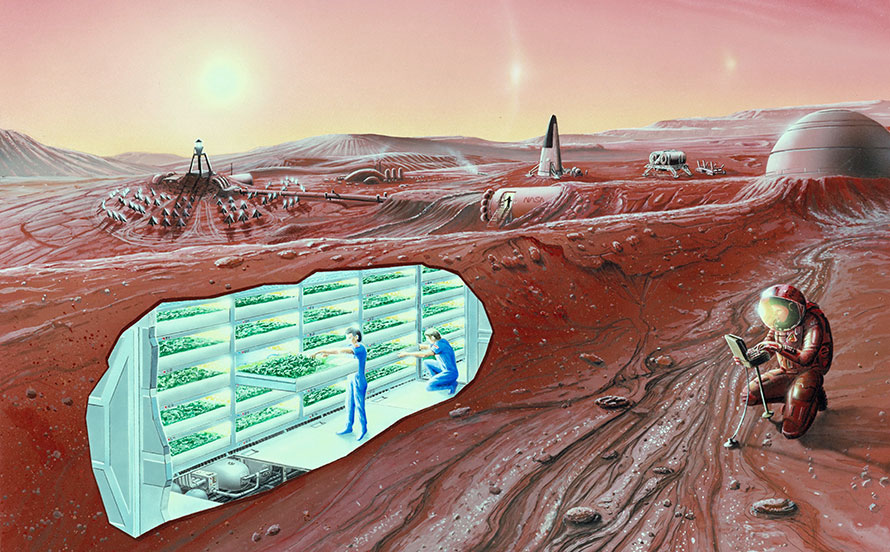 A primarily subsurface Mars settlement showing habitats covered by regolith, growing areas, industrial areas, energy production, surface airlocks, and utilities. Image: NASA
A primarily subsurface Mars settlement showing habitats covered by regolith, growing areas, industrial areas, energy production, surface airlocks, and utilities. Image: NASA
BARRIERS
- The lack of a developed and affordable commercial transport system to get large numbers of civilians to Mars with a sufficiently low radiation dose.
- The need to develop the ability to build pressurized structures from local Mars materials, such as steel from hematite, since millions of tons of habitats cannot be imported from Earth.
- The need to develop sufficiently large power sources on a world totally devoid of fossil fuels.
- Concerns about and lack of agreement on planetary protection protocols for human settlement on Mars.
COMPLETION
This milestone can be considered achieved when a growing settlement of at least 1000 adults has been there long enough for one generation to be born on Mars who in turn have had viable children.







